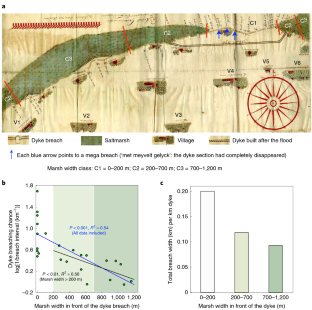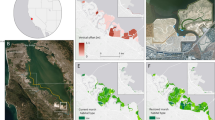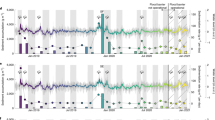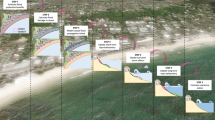Abstract
Global change amplifies coastal flood risks and motivates a paradigm shift towards nature-based coastal defence, where engineered structures are supplemented with coastal wetlands such as saltmarshes. Although experiments and models indicate that such natural defences can attenuate storm waves, there is still limited field evidence on how much they add safety to engineered structures during severe storms. Using well-documented historic data from the 1717 and 1953 flood disasters in Northwest Europe, we show that saltmarshes can reduce both the chance and impact of the breaching of engineered defences. Historic lessons also reveal a key but unrecognized natural flood defence mechanism: saltmarshes lower flood magnitude by confining breach size when engineered defences have failed, which is shown to be highly effective even with long-term sea level rise. These findings provide new insights into the mechanisms and benefits of nature-based mitigation of flood hazards, and should stimulate the development of novel safety designs that smartly harness different natural coastal defence functions.
This is a preview of subscription content, access via your institution
Access options
Access Nature and 54 other Nature Portfolio journals
Get Nature+, our best-value online-access subscription
$29.99 / 30 days
cancel any time
Subscribe to this journal
Receive 12 digital issues and online access to articles
$119.00 per year
only $9.92 per issue
Buy this article
- Purchase on Springer Link
- Instant access to full article PDF
Prices may be subject to local taxes which are calculated during checkout






Similar content being viewed by others
Data availability
The collected wave data for the two present-day storms are available on figshare (https://doi.org/10.6084/m9.figshare.6011129.v2). Other data that support the findings of this study are available within the paper and its supplementary information files.
Code availability
The Matlab scripts for calculating breach discharge and the expected fatality rate in the flooded area are available on figshare (https://doi.org/10.6084/m9.figshare.6010958).
References
Barbier, E. B. A global strategy for protecting vulnerable coastal populations. Science 345, 1250–1251 (2014).
Hallegatte, S., Green, C., Nicholls, R. J. & Corfee-Morlot, J. Future flood losses in major coastal cities. Nat. Clim. Change 3, 802–806 (2013).
Blake E. S., Rappaport E. N. and Landsea C. W. The Deadliest, Costliest, and Most Intense United States Tropical Cyclones from 1851 to 2006 (and other frequently requested hurricane facts) (National Oceanic and Atmospheric Administration/National Weather Service, National Centers for Environmental Prediction, National Hurricane Center, 2007).
Nakamura, R., Shibayama, T., Esteban, M. & Iwamoto, T. Future typhoon and storm surges under different global warming scenarios: case study of typhoon Haiyan (2013). Nat. Hazards 82, 1645–1681 (2016).
Rijkswaterstaat & KNMI Verslag over de Stormvloed van 1953 (Staatsdrukkerij, 1961).
Gerritsen, H. What happened in 1953? The Big Flood in the Netherlands in retrospect. Philos. Trans. R. Soc. A 363, 1271–1291 (2005).
Jakubowski-Tiessen, M. Sturmflut 1717: die Bewältigung einer Naturkatastrophe in der frühen Neuzeit (Oldenbourg, 1992).
Lamb, H. & Frydendahl, K. Historic Storms of the North Sea, British Isles and Northwest Europe (Cambridge Univ. Press, 1991).
Wahl, T. et al. Understanding extreme sea levels for broad-scale coastal impact and adaptation analysis. Nat. Commun. 8, 16075 (2017).
IPCC Special Report on Global Warming of 1.5 °C (eds Masson-Delmotte, V. et al.) (WMO, 2018).
Syvitski, J. P. M. et al. Sinking deltas due to human activities. Nat. Geosci. 2, 681–686 (2009).
Neumann, B., Vafeidis, A. T., Zimmermann, J. & Nicholls, R. J. Future coastal population growth and exposure to sea-level rise and coastal flooding - a global assessment. PLoS ONE 10, e0118571 (2015).
Cheong, S.-M. et al. Coastal adaptation with ecological engineering. Nat. Clim. Change 3, 787–791 (2013).
Temmerman, S. et al. Ecosystem-based coastal defence in the face of global change. Nature 504, 79–83 (2013).
Temmerman, S. & Kirwan, M. L. Building land with a rising sea. Science 349, 588–589 (2015).
Vuik, V., Jonkman, S. N., Borsje, B. W. & Suzuki, T. Nature-based flood protection: the efficiency of vegetated foreshores for reducing wave loads on coastal dikes. Coast. Eng. 116, 42–56 (2016).
Barbier, E. B. et al. The value of estuarine and coastal ecosystem services. Ecol. Monogr. 81, 169–193 (2011).
Kirwan, M. L., Temmerman, S., Skeehan, E. E., Guntenspergen, G. R. & Fagherazzi, S. Overestimation of marsh vulnerability to sea level rise. Nat. Clim. Change 6, 253–260 (2016).
Kirwan, M. L. & Megonigal, J. P. Tidal wetland stability in the face of human impacts and sea-level rise. Nature 504, 53–60 (2013).
Moller, I. et al. Wave attenuation over coastal salt marshes under storm surge conditions. Nat. Geosci. 7, 727–731 (2014).
Arkema, K. K. et al. Coastal habitats shield people and property from sea-level rise and storms. Nat. Clim. Change 3, 913–918 (2013).
Narayan, S. et al. The value of coastal wetlands for flood damage reduction in the northeastern USA. Sci. Rep. 7, 9463 (2017).
Visser, P. J. Breach Growth in Sand-Dikes. PhD thesis, Delft Univ. Technology (1998).
Bouma, T. J. et al. Identifying knowledge gaps hampering application of intertidal habitats in coastal protection: opportunities & steps to take. Coast. Eng. 87, 147–157 (2014).
Seeratt, T. V. Journaal van de Commies Provinciaal Thomas van Seeratt Betref de Dijken over de Jaren 1716–1721 Archive no. 818 (Groninger Archives, 1730).
Willemsen, P. W., Borsje, B. W., Vuik, V., Bouma, T. J. & Hulscher, S. J. Field-based decadal wave attenuating capacity of combined tidal flats and salt marshes. Coast. Eng. 156, 103628 (2020).
Spencer, T. et al. Salt marsh surface survives true-to-scale simulated storm surges. Earth Surf. Process. Landf. 41, 543–552 (2016).
Jonkman, S. N., Bočkarjova, M., Kok, M. & Bernardini, P. Integrated hydrodynamic and economic modelling of flood damage in the Netherlands. Ecol. Econ. 66, 77–90 (2008).
Auerbach, L. W. et al. Flood risk of natural and embanked landscapes on the Ganges–Brahmaputra tidal delta plain. Nat. Clim. Change 5, 153–157 (2015).
Minderhoud, P. S. J., Coumou, L., Erkens, G., Middelkoop, H. & Stouthamer, E. Mekong delta much lower than previously assumed in sea-level rise impact assessments. Nat. Commun. 10, 3847 (2019).
Van Coppenolle, R., Schwarz, C. & Temmerman, S. Contribution of mangroves and salt marshes to nature-based mitigation of coastal flood risks in major deltas of the world. Estuar. Coast. 41, 1699–1711 (2018).
Van Coppenolle, R. & Temmerman, S. A global exploration of tidal wetland creation for nature-based flood risk mitigation in coastal cities. Estuar. Coast. Shelf Sci. 226, 106262 (2019).
Vuik, V., van Vuren, S., Borsje, B. W., van Wesenbeeck, B. K. & Jonkman, S. N. Assessing safety of nature-based flood defenses: dealing with extremes and uncertainties. Coast. Eng. 139, 47–64 (2018).
Schuerch, M., Spencer, T. & Evans, B. Coupling between tidal mudflats and salt marshes affects marsh morphology. Mar. Geol. 412, 95–106 (2019).
Wiberg, P. L., Fagherazzi, S. & Kirwan, M. L. Improving predictions of salt marsh evolution through better integration of data and models. Annu. Rev. Mar. Sci. 12, 389–413 (2020).
Leonardi, N., Ganju, N. K. & Fagherazzi, S. A linear relationship between wave power and erosion determines salt-marsh resilience to violent storms and hurricanes. Proc. Natl Acad. Sci. USA 113, 64–68 (2016).
Mariotti, G. & Fagherazzi, S. A numerical model for the coupled long-term evolution of salt marshes and tidal flats. J. Geophys. Res. Earth Surf. 115, F01004 (2010).
Ladd, C. J., Duggan-Edwards, M. F., Bouma, T. J., Pagès, J. F. & Skov, M. W. Sediment supply explains long-term and large-scale patterns in salt marsh lateral expansion and erosion. Geophys. Res. Lett. 46, 11178–11187 (2019).
Friess, D. A. et al. Are all intertidal wetlands naturally created equal? Bottlenecks, thresholds and knowledge gaps to mangrove and saltmarsh ecosystems. Biol. Rev. 87, 346–366 (2012).
Vandenbruwaene, W. et al. Sedimentation and response to sea-level rise of a restored marsh with reduced tidal exchange: comparison with a natural tidal marsh. Geomorphology 130, 115–126 (2011).
Jongepier, I., Soens, T., Temmerman, S. & Missiaen, T. Assessing the planimetric accuracy of historical maps (sixteenth to nineteenth centuries): new methods and potential for coastal landscape reconstruction. Cartogr. J. 53, 114–132 (2016).
Groeneweg, J. et al. Wave modelling in a tidal inlet: performance of SWAN in the Wadden Sea. In Coastal Engineering 2008: Proc. 31st International Conference on Coastal Engineering (ed. Smith, J. M.) 411–423 (World Scientific, 2009).
Groeneweg, J., Beckers, J. & Gautier, C. A probabilistic model for the determination of hydraulic boundary conditions in a dynamic coastal system. In Coastal Engineering 2010: Proc. 32nd International Conference on Coastal Engineering (eds Smith, J. M. & Lynett, P.) (ICEE, 2011).
Booij, N., Ris, R. & Holthuijsen, L. H. A third‐generation wave model for coastal regions: 1. model description and validation. J. Geophys. Res. Oceans 104, 7649–7666 (1999).
Niemeyer, H. D., Kaiser, R. & Berkenbrink, C. Increased overtopping security of dykes: a potential for compensating future impacts of climate change. In Coastal Engineering 2010: Proc. 32nd International Conference on Coastal Engineering (eds Smith, J. M. & Lynett, P.) (ICEE, 2011).
Grüne, J. Evaluation of wave climate parameters from benchmarking flotsam levels. In Proc. International Conference on Coastlines, Structures and Breakwaters (ed. Allsop, N. W. H.) 468–477 (Thomas Telford Publishing, 2005).
Jonkman, S. N. Loss of Life Estimation in Flood Risk Assessment: Theory and Applications. PhD thesis, Delft Univ. Technology (2007).
Jonkman, S. N., Vrijling, J. K. & Vrouwenvelder, A. C. W. M. Methods for the estimation of loss of life due to floods: a literature review and a proposal for a new method. Nat. Hazards 46, 353–389 (2008).
IPCC Climate Change 2013: The Physical Science Basis (eds Stocker, T. F. et al.) (Cambridge Univ. Press, 2014).
Shapiro, S. S. & Wilk, M. B. An analysis of variance test for normality (complete samples). Biometrika 52, 591–611 (1965).
Acknowledgements
We thank I. Kratzer and J. de Smit for their help in the field. We also thank A. Wielemaker for GIS support and Q. Zhu for the assistance in polishing the figures. This work is part of the research programme BESAFE, financed by the Netherlands Organization for Scientific Research (NWO). Additional financial support has been provided by Deltares, Boskalis, Van Oord, Rijkswaterstaat, World Wildlife Fund, HZ University of Applied Science and ARK Natuurontwikkeling. Z.Z. was also supported by the project funded by the China Postdoctoral Science Foundation (2019M652825) and the Key Special Project for Introduced Talents Team of the Southern Marine Science and Engineering Guangdong Laboratory (Guangzhou; GML2019ZD0403).
Author information
Authors and Affiliations
Contributions
Z.Z., V.V., S.T. and T.J.B. conceived the idea for the paper and wrote the initial draft. Z.Z., V.V., T.S., P.J.V. and S.N.J. collected and analysed the data. All authors discussed the results and improved on the manuscript.
Corresponding author
Ethics declarations
Competing interests
The authors declare no competing interests.
Additional information
Publisher’s note Springer Nature remains neutral with regard to jurisdictional claims in published maps and institutional affiliations.
Supplementary information
Supplementary Information
Supplementary Figs. 1–4 and Tables 1–3.
Supplementary Data
Supplementary Data 1
Rights and permissions
About this article
Cite this article
Zhu, Z., Vuik, V., Visser, P.J. et al. Historic storms and the hidden value of coastal wetlands for nature-based flood defence. Nat Sustain 3, 853–862 (2020). https://doi.org/10.1038/s41893-020-0556-z
Received:
Accepted:
Published:
Issue Date:
DOI: https://doi.org/10.1038/s41893-020-0556-z
This article is cited by
-
The evolution and future of research on Nature-based Solutions to address societal challenges
Communications Earth & Environment (2024)
-
A mud budget of the Wadden Sea and its implications for sediment management
Communications Earth & Environment (2024)
-
The evolving landscape of sea-level rise science from 1990 to 2021
Communications Earth & Environment (2023)
-
Subsidence reveals potential impacts of future sea level rise on inhabited mangrove coasts
Nature Sustainability (2023)
-
Coral reef structural complexity loss exposes coastlines to waves
Scientific Reports (2023)



